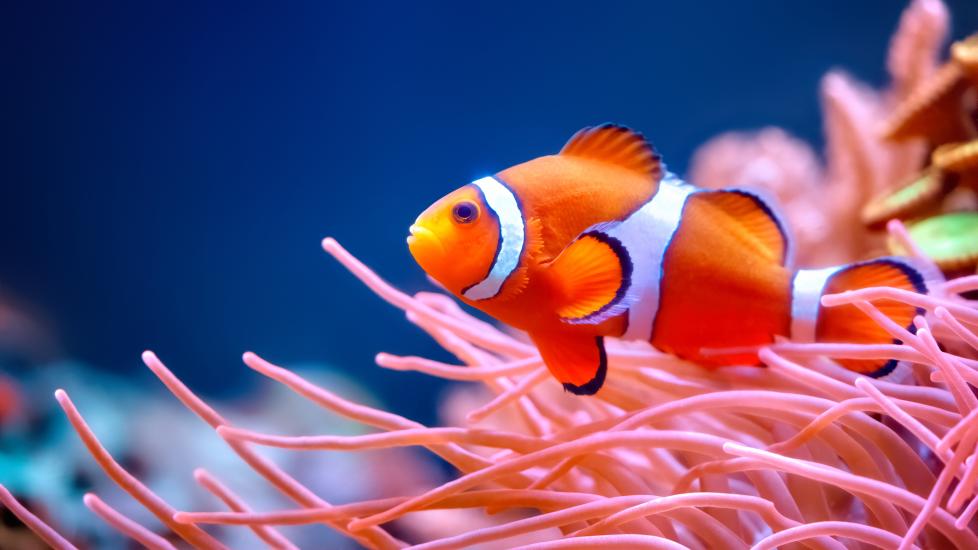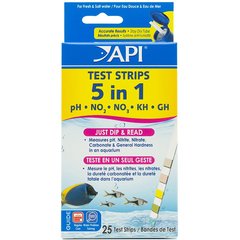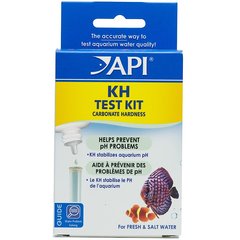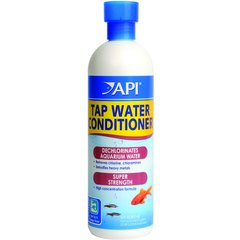Clownfish Care Sheet
Clownfish Species Overview
Clownfish are one of the most recognizable saltwater pet fish species. This care sheet outlines basic care needs for a variety of clownfish pet species, including:
-
Ocellaris clownfish (shown above)
-
Percula clownfish
-
Tomato clownfish
-
Clarkii clownfish
-
Maroon clownfish
-
Skunk clownfish
-
Spotcinctus clownfish
-
Cinnamon clownfish
-
Saddleback clownfish
Although pet clownfish are frequently recognized as orange and white, they come in a variety of colors and patterns.
The clownfish is active and well known for its symbiotic relationship with sea anemones. Before deciding to house a clownfish pet and anemone in the same aquarium, research the specific pet fish to find a suitable pairing.
Some clownfish tend to be territorial toward pet fish of the same species, but clownfish are closely related to damselfish and the two species can sometimes live together harmoniously if provided with enough space.
Mated pairs of clownfish pets are also known to breed in home aquariums when kept together.
Clownfish Characteristics
|
Difficulty of Care |
Beginner |
|
Average Lifespan |
Up to 20 years with proper care, depending on species |
|
Average Adult Size |
6 inches long, depending on species |
|
Diet |
Omnivorous |
|
Minimum Habitat Size |
29+ gallons, depending on species |
|
Water Temperature |
74–80 F |
|
Specific Gravity |
1.020–1.025 |
|
pH |
7.8 to 8.4 |
Clownfish Supply Checklist
To keep a clownfish pet happy and healthy, pet parents should have these basic supplies on hand:
-
Appropriately sized aquarium
-
Appropriate food, dry and frozen
-
Décor
-
Water conditioner
-
Aquarium salt
-
Filter
-
Water test kit
-
Full-spectrum lighting
-
Net
-
Thermometer
-
Protein skimmer
-
Marine substrate
-
Heater
-
Refractometer
-
Live rock
Clownfish Habitat
Choosing the Right Enclosure
A single adult clownfish pet will need an aquarium that’s at least 29 gallons in capacity, depending on the species. Ideally, aquariums should be long, with a large bottom surface area (or “footprint”) so the fish has plenty of space to hide and set up territories.
Aquariums should be kept in a quiet area of the home, away from direct sunlight, windows, or air conditioners. Because water conditions can change rapidly in smaller water volumes, pet parents should always provide their pet fish with the largest habitat possible. If more than one pet fish is housed in the same tank, the aquarium’s size should be increased accordingly.
Selecting Tankmates
Certain pet clownfish, such as maroon clowns, must be kept singly unless part of a mated pair. Some species may also benefit from living alongside sea anemones, which are marine invertebrates similar to jellyfish. Pet parents should research species-to-species compatibility before deciding to keep clownfish and anemones in the same tank.
Clownfish are usually most compatible with:
-
Dwarf and large angelfish
-
Blennies
-
Gobies
-
Hawkfish
-
Pseudochromis
-
Puffers
-
Tangs
-
Wrasses
-
Hogfish
-
Foxface/Rabbitfish
-
Butterflyfish
-
Basslets
-
Anthias
-
Dartfish
-
Cardinalfish
Some clownfish pet types are known to be territorial toward fish of the same species. Pet parents should watch their aquarium for fighting and other signs of aggression between tankmates. If two fish fight, they should be separated.
New tankmates must be introduced to the aquarium gradually, as the tank’s ammonia, pH, and nitrate levels will change when a new fish is introduced. These parameters should be watched carefully after the new fish is added. Clownfish should not be kept in overcrowded aquariums, as this often leads to stress and disease in the fish tank.
Filtration
An aquarium filter system is an essential addition to any aquatic habitat. In addition to keeping tanks clean, filters remove harmful toxins like ammonia from the aquarium's water and add oxygen to the water so fish can breathe. An aquarium’s filter should be powerful enough to process all the water in the tank at least four times an hour. For example, a 30-gallon tank should ideally have an aquarium filter with a flow rate that’s at least 120 gallons per hour (GPH). If only a 100 or 150 GPH filter is available, pet parents should purchase the 150 GPH option.
Power filters (also known as “hang-on-back" filters) and external canister filters are recommended because they offer effective mechanical, biological, and chemical filtration and do not take up any space inside an aquarium.
Clownfish prefer fish tanks with low to moderate water circulation, so pet parents should look for a filter that allows them to control the flow rate so they can keep current speeds low in the tank.
Water Health and Salt Content
Pet parents should test their aquarium’s water regularly to ensure its pH, ammonia, nitrate, and nitrite levels are stable and within a safe range. An aquarium test kit can be used to measure key water parameters quickly and accurately.
As a type of saltwater fish, pet clownfish need marine salt in their aquarium to survive. When setting up their tank, pet parents should add small amounts of marine salt to their clownfish’s habitat until the water’s specific gravity is between 1.020 and 1.025. The specific gravity reading should not change more than +/- 0.001 in 24 hours.
A hydrometer or refractometer (salt level tester) should be used to measure the salt concentration and specific gravity of the aquarium’s water.
Temperature
As a type of tropical fish, clownfish prefer warm water that’s 74 to 80 F. An aquatic heater should be installed in the tank to ensure that water temperatures stay within an ideal range and do not fluctuate more than +/- 2 F in a single day. Heaters should be paired with a thermostat to regulate the aquarium’s temperature and prevent the water from rising above the ideal range. Many modern heaters often have built-in thermostats.
The wattage needed for the aquarium heater will depend on the enclosure’s size and the ambient temperature of the room in which the tank is kept. As a rule, aquarium heaters should have between 2.5 and 5 watts of power for every gallon of water in a tank. This means that a 30-gallon tank needs a 75- to 150-watt heater. Larger aquariums with a tank volume over 50 gallons may need two small heaters, placed on opposite sides of the tank, to prevent cold spots from developing.
Pet parents must check the water temperature of their clownfish’s tank daily with an aquarium thermometer.
Décor and Accessories
Substrate
The bottom of a pet clownfish’s tank should be lined with at least 1–2 inches of a sand or gravel substrate that’s safe for marine habitats.
Aquariums need about 1.5 pounds of substrate for each gallon of water in the tank. For example, a 10-gallon tank will require about 15 pounds of substrate to create a 1- to 2-inch layer.
Be sure to rinse the substrate with clean running water before adding it to the fish tank.
Hiding Places and Caves
Clownfish enjoy hiding in or near a cave, coral, crevices, or anemones, and they sometimes dart out to defend their territory or to capture food.
All décor should be rinsed thoroughly before being added to the tank.
Live Rock
Pet parents can decorate their clownfish’s habitat with live rock. Aside from creating hiding places within the tank, live rock can act as a natural biological filter in a clownfish’s aquarium.
Live rock is not actually alive. “Live” refers to the good bacteria and macroscopic life that live inside and on the surface of the rock.
Live rock should be cured (tested and treated to remove dead or decaying microorganisms living in and on it that can increase the ammonia levels of the tank and that should be removed before the rock is added to the tank) before being added to the aquarium.
Always wear gloves while handling live rock or performing any maintenance on the aquarium.
Plants and Other Rocks
Pet parents can use plants and rocks to add some aesthetic flair and create hiding places in their clownfish’s tank.
Submerged plants should be well-secured in the tank’s substrate to prevent them from toppling over and injuring a fish.
Protein Skimmer
Adding an appropriately sized protein skimmer to a pet clownfish’s tank can help support water quality and high dissolved oxygen levels within the aquarium.
Clownfish Cleaning and Maintenance
Pet parents can maintain the condition of their clownfish’s tank by performing routine water changes (no more than 10–25% of the aquarium’s total water volume) every two to four weeks. Draining and replacing the aquarium's entire water volume should be avoided, as doing so will remove beneficial bacteria in the tank that keep the habitat’s ecosystem healthy.
Most aquariums will need a full cleaning about once a month, depending on the number of pet fish in the tank. To fully clean a fish tank, take these steps:
-
Before cleaning or performing any maintenance on an aquarium, hands should be rinsed and washed thoroughly, ensuring that there isn’t any trace residue of lotions, perfumes, or other toxic chemicals that can harm fish. Do not remove the fish from the aquarium; it will stress them out and could injure them.
-
Use a soft sponge or scrubber to scrape the inside walls of the aquarium. To prevent unsightly scratches, acrylic tanks should only be cleaned with specialized cleaning tools designed for acrylic aquariums, such as the API® Extra Long Algae Scraper for Acrylic Aquariums or API® Algae Pad for Acrylic Aquariums.
-
Remove the aquarium’s accessories and any artificial plants that have significant algae growth. Use an algae pad and hot water to scrub any buildup or debris.
-
If the décor is still visibly dirty after being scrubbed, use a 3% bleach solution to remove the stubborn buildup. Accessories should soak in the diluted bleach solution for 15 minutes before being rinsed thoroughly with running water until there are no residual smells from the bleach. After cleaning, leave the accessories to fully air-dry.
-
Inspect the aquarium’s filter to ensure it’s working properly and doesn’t have any algae buildup. If the filter needs to be cleaned, follow the manufacturer's instructions.
-
Use a siphon vacuum to remove waste or old food from the bottom of the tank. This step will also drain water from the tank and prepare the aquarium for a water change.
-
Once the aquarium’s gravel is vacuumed, check on the cleaned décor to ensure that all furnishings are fully dried and do not have a bleachy smell before adding them back to the tank.
-
Add new dechlorinated water to the tank to replace the water that was siphoned out. The new water must be detoxified with a water conditioner to remove toxic chemicals like chlorine, chloramines, and heavy metals.
-
Use an aquarium-safe cleaner to clean the outer walls of the aquarium. Household cleaners should be avoided, as they often have ammonia and other chemicals that are toxic to fish.
Clownfish Diet and Nutrition
Clownfish are omnivorous and should be fed in small amounts, two to three times each day. At each feeding session, the fish should be able to consume all the food added to its tank within one to two minutes. Any uneaten food should be removed from the tank daily.
A nutritious and well-balanced diet for a clownfish consists of appropriately sized flakes, pellets, or frozen food; pet parents should vary the type of food they offer to their clownfish to ensure the fish’s diet is nutritionally balanced. Frozen food must be thawed before feeding.
Clownfish Care
To keep pet clownfish healthy, pet parents should change 10–25% of the total volume of their aquarium’s water every two to four weeks, or more often if needed.
After a new fish or new equipment is added to an aquarium, it’s important to test the tank water’s quality once a week for at least two months to ensure that its pH, nitrite, ammonia, nitrate, carbonate, and general hardness levels are in the ideal range.
If the results are safe and consistent after two months, pet parents can decrease water testing to once a month.
Water test kits expire and should be replaced yearly.
Monitor your aquarium's water level and top it off as needed. Before being added to an aquarium, water must be treated with a water conditioner to remove toxic chemicals like chlorine, chloramines, and heavy metals. Any water added should be at the same temperature and salinity as the existing water in the tank.
An aquarium’s water temperature should be checked daily, along with its filter and other equipment to ensure that everything is working properly. Filter media should be replaced monthly or rinsed in old tank water during water changes, depending on the water condition and the number of fish in the tank.
Do not use hot water, bleach, or chemicals while rinsing filter media. This will kill the beneficial bacteria that helps keep aquatic habitats safe, clean, and stable.
Avoid replacing all the filtration media in an aquarium at the same time, as this can also remove beneficial bacteria from the tank.
Uneaten food should be removed from an aquarium daily. Food can be removed using a fine-mesh fish net.
Clownfish Veterinary Care
It is OK to use a veterinarian only if there is a problem with your clownfish in a properly maintained tank of appropriate size. Almost all clownfish first introduced to your home will likely have at least one health issue, so it is recommended to have them and your setup assessed by a veterinarian within a week. While a clownfish can be transported to a vet, it is recommended that you find an aquatics veterinarian who will more than likely make house calls, as transport is a major stress event for fish.
Signs of a Healthy Clownfish
-
Bright coloration
-
Full range of motion of fin movement, equal on both sides
-
Intact fins all the way to the edges with no discoloration
-
Regular and active swim pattern
-
Large appetite
When to Call a Vet
-
Lethargic swimming, potentially with an abnormal pattern such as circling, listing to the side, or staying on the top or bottom of the tank
-
Receding fin edges with or without discoloration at the edges
-
Decreased appetite for more than a day
-
Itching
-
Rapid breathing, potentially with flared gills
-
Gill color changes
-
Presence of lumps/bumps/masses
-
White growths/spots of any kind
Common Illnesses in Clownfish
-
Fin/tail rot
-
Dropsy (fluid-filled coelomic cavity)
-
Parasites
-
Bacterial infections
-
Cancer
-
Ich
-
Pop eye
-
Fungal oral or skin infections
-
Swim bladder disorders
Clownfish FAQs
Are clownfish endangered in 2023?
Clownfish pets are not endangered, but their populations have decreased in some areas due to over-capture of wild clownfish for the aquarium trade, leading to some individual species with lower-than-normal populations.
How big can clownfish get?
Clownfish pets can grow to about 4 to 4.5 inches, with the females being larger than the males.
How long do clownfish live?
This can vary based on individual clownfish species, but there are reports of some clownfish living over 25 years!
Do clownfish have 400 eggs?
This is actually on the low end of the estimate. They can have as many as 1,500 eggs!
Featured Image: Antagain/E+ via Getty Images Plus



